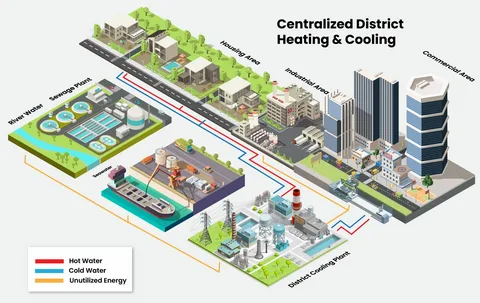As Singapore advances toward becoming a Smart Nation, the construction and real estate sectors are witnessing a growing trend in the adoption of smart buildings. These structures are designed to be energy-efficient, sustainable, and integrated with advanced technologies. One of the key pillars of this transformation is the move toward greener cooling solutions, particularly as cooling demand increases with urban density. Among the most impactful innovations in this space is the district cooling system, which is rapidly gaining traction across new urban developments. From the Marina Bay Financial Centre to upcoming smart city zones, district cooling is becoming a cornerstone of sustainable building design in Singapore.
What is a District Cooling System?
A district cooling system is a centralised system that produces and distributes chilled water from a central plant to multiple buildings in a defined area. Unlike traditional air conditioning units installed individually in each building, district cooling delivers cooling as a service, much like utilities such as electricity or water. The chilled water is circulated through a network of underground pipes, cooling air in each building before returning to the central plant for re-chilling.
This system is especially beneficial for smart buildings, which are designed with digital controls and energy optimisation features. With seamless integration into building management systems, district cooling helps these buildings automate energy usage and reduce operational costs while improving sustainability.
Top Benefits of District Cooling in Smart Buildings
Energy Efficiency and Cost Savings
One of the standout advantages of district cooling systems in Singapore is their high energy efficiency. These systems consume up to 40% less electricity compared to conventional air conditioning. By centralising the cooling process and benefiting from economies of scale, both building owners and tenants enjoy significantly lower electricity bills. Smart buildings can further optimise their energy use by leveraging real-time data analytics to match cooling supply with actual demand. Notable developments like Marina Bay Financial Centre have already demonstrated major cost and energy savings through district cooling adoption.
Reduced Carbon Footprint
District cooling directly supports Singapore’s commitment to sustainable development and carbon neutrality. By reducing the energy needed for cooling, these systems contribute to lower greenhouse gas emissions. They can also be powered by clean energy sources or be part of an integrated energy system. This aligns with green building certifications and the Green Building Council of Singapore’s sustainability initiatives, making district cooling a vital tool in climate-conscious urban planning.
Space-Saving and Aesthetics
In a space-scarce city like Singapore, eliminating the need for large air conditioning units and complex ductwork is a significant benefit. District cooling frees up valuable floor area that can be used for commercial or residential purposes, enhancing property value. Moreover, it improves building aesthetics by removing bulky outdoor units and pipes, giving architects more flexibility in facade and interior designs.
Reliability and Maintenance
With fewer moving parts distributed across buildings, maintenance costs are lower and system reliability is higher. District cooling systems are designed with built-in redundancy, ensuring uninterrupted service even during peak demand or system faults. This is especially important for smart buildings that depend on consistent environmental control for data centres, commercial spaces, or healthcare facilities.
Scalability for Future Growth
District cooling is inherently scalable, making it a future-proof choice for developers. As more buildings are added to an estate or urban zone, the central plant’s capacity can be expanded to meet growing cooling demands. This adaptability makes district cooling ideal for dynamic urban districts like Jurong Lake District, where long-term planning and flexibility are essential.
Case Studies of Successful District Cooling Installations in Singapore
Several high-profile Singapore developments have successfully implemented district cooling. In Marina Bay, for example, the centralised system has reduced energy consumption by over 40%, helping building owners cut operational costs significantly. In Suntec City, district cooling has enabled efficient building operations across a mixed-use complex. Jurong Lake District, Singapore’s largest commercial hub outside the CBD, is also being planned with district cooling infrastructure to meet future demands sustainably. These examples underscore the technology’s potential and real-world effectiveness.
The Future of District Cooling in Singapore’s Smart Cities
District cooling is poised to play a key role in shaping Singapore’s Smart Nation vision. With increasing attention on sustainability, digitalisation, and urban resilience, district cooling aligns perfectly with government initiatives like the Green Plan 2030 and the goal of net zero emissions by 2050. The upcoming Greater Southern Waterfront is expected to integrate district cooling as part of its master plan, demonstrating the model’s scalability and national relevance.
The Smart Choice for a Greener, Cooler Singapore
District cooling systems offer an ideal solution for smart buildings in Singapore, delivering long-term energy efficiency, cost savings, and environmental benefits. From freeing up space and enhancing aesthetics to improving reliability and future scalability, district cooling is quickly becoming the preferred choice in modern urban developments. For property developers, building owners, and planners, adopting district cooling means aligning with Singapore’s vision of a sustainable and smart future. To explore district cooling system solutions tailored to your project, consult with expert providers and gas pipe contractors in Singapore for a seamless integration from planning to implementation.

